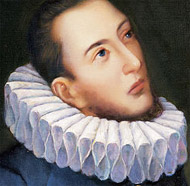A man of violent temperament and ferocious passions, Carlo
Gesualdo was as notorious for having murdered his first wife and
her lover as he was famous for his music. One of classical music's
great experimenters, he displayed an individual approach seen
clearly in his madrigals.
Don Carlo Gesualdo was an Italian nobleman, Prince of Venosa.
He lived most of his life in Naples, where his uncle was
archbishop (later a cardinal). Although he initially used a
pseudonym to disguise his real love of writing music, discretion
was not his best trait. His controversial marriage to his own
cousin, Maria d'Avalos, came to an abrupt end in 1590 when he
discovered that she was engaged in an affair with another
nobleman: Gesualdo murdered them both. After this incident he continued his musical career under his own name.
In 1594 he entered a rather more conventionally acceptable
marriage with Leonora d'Este, the niece of Duke Alfonso of
Ferrara. The couple led largely separate lives; but the Ferrara
court, being a thriving centre of musical and artistic activity,
was ideal for Gesualdo, and he published his first four books of
madrigals there between 1593 and 1596. He returned to Naples in
1597, and as he grew older became distinctly world-weary, turning
more and more to his music. Rumours circulated of possible divorce
and there was speculation concerning his sanity. He became
preoccupied by morbid reverence towards his late uncle; he was
also deeply concerned about the end of the family line. His and
Leonora's only son, Alfonsino, died in 1600, a tragedy that
prompted him to commission the famous altarpiece in the church of
the Capuchins at Gesualdo which portrays himself, Leonora, his
revered uncle and the purified soul of the child.
Writing during the transitional period when the controlled
style of the Renaissance was giving way to the more dramatic
expressiveness of the Baroque, Gesualdo brought an extreme, ardent
individuality to his music. Nowhere is this more evident than in
his madrigals (especially in his fifth and sixth books, published
in 1611). To express changes in mood — doubtless a reflection of
his unstable emotional state — he used a violent chromaticism. (Chromaticism
is the use of chords containing notes not included in the basic
scale.) Although he was writing within the strong madrigal
tradition, and like his peers producing works for three to five
unaccompanied voices, his unorthodox techniques were far in
advance of his time and can border on the eccentric. As such
Gesualdo's style did not influence future generations (although
Stravinsky was intrigued by the chromatic explorations of his
madrigals). Nevertheless his compositions display a truly original
voice made comprehensible by his mastery of the technical
requirements of writing music and by an undeniably compelling
emotional power.
|



No comments:
Post a Comment